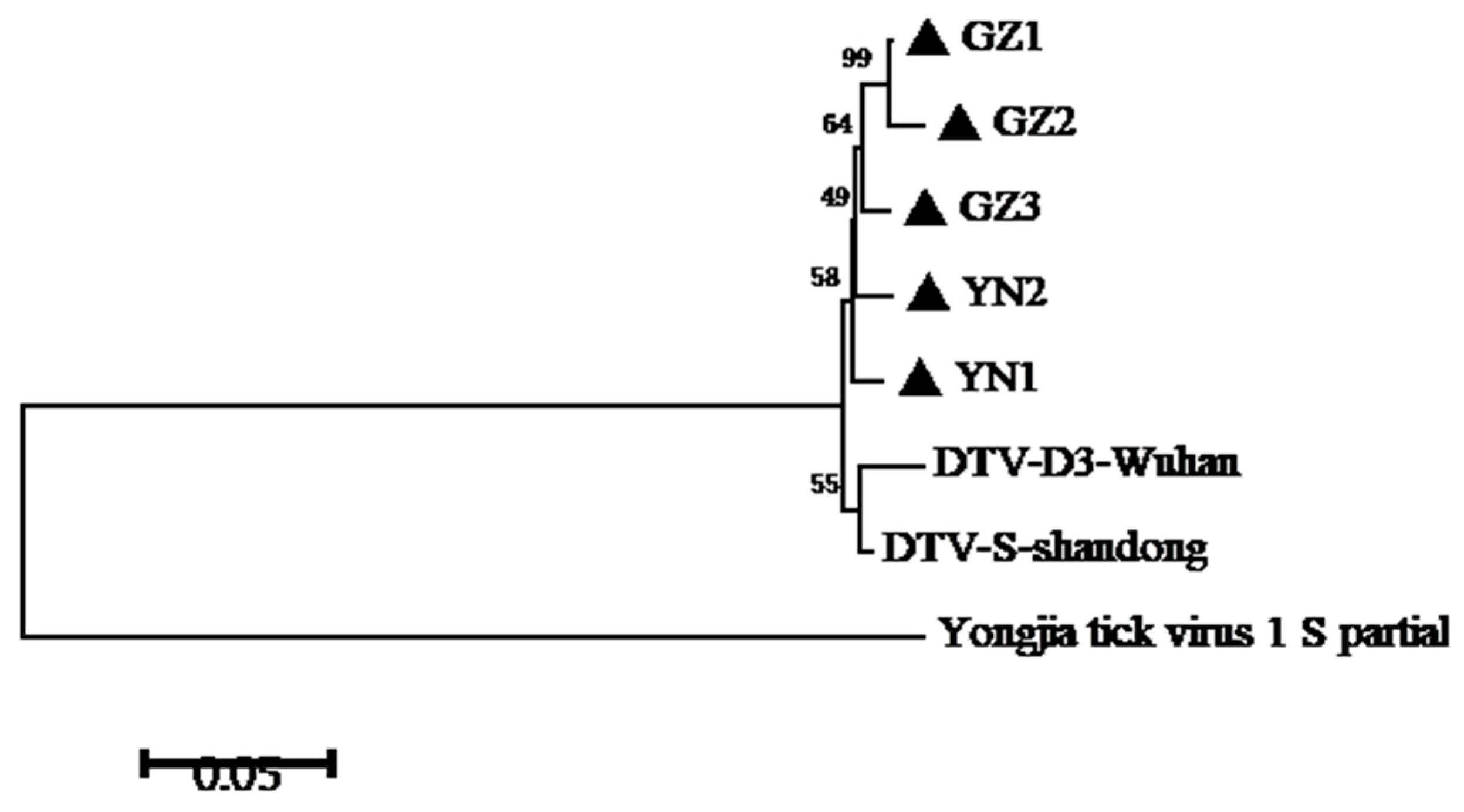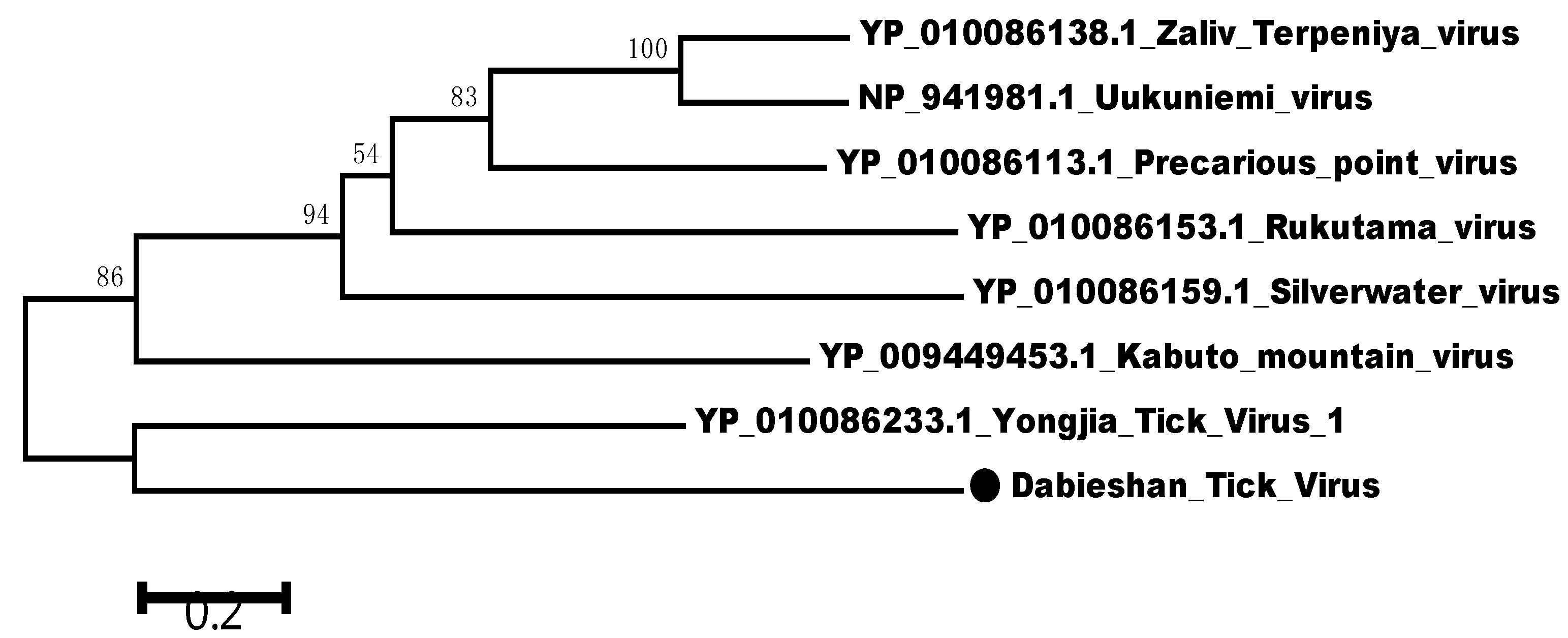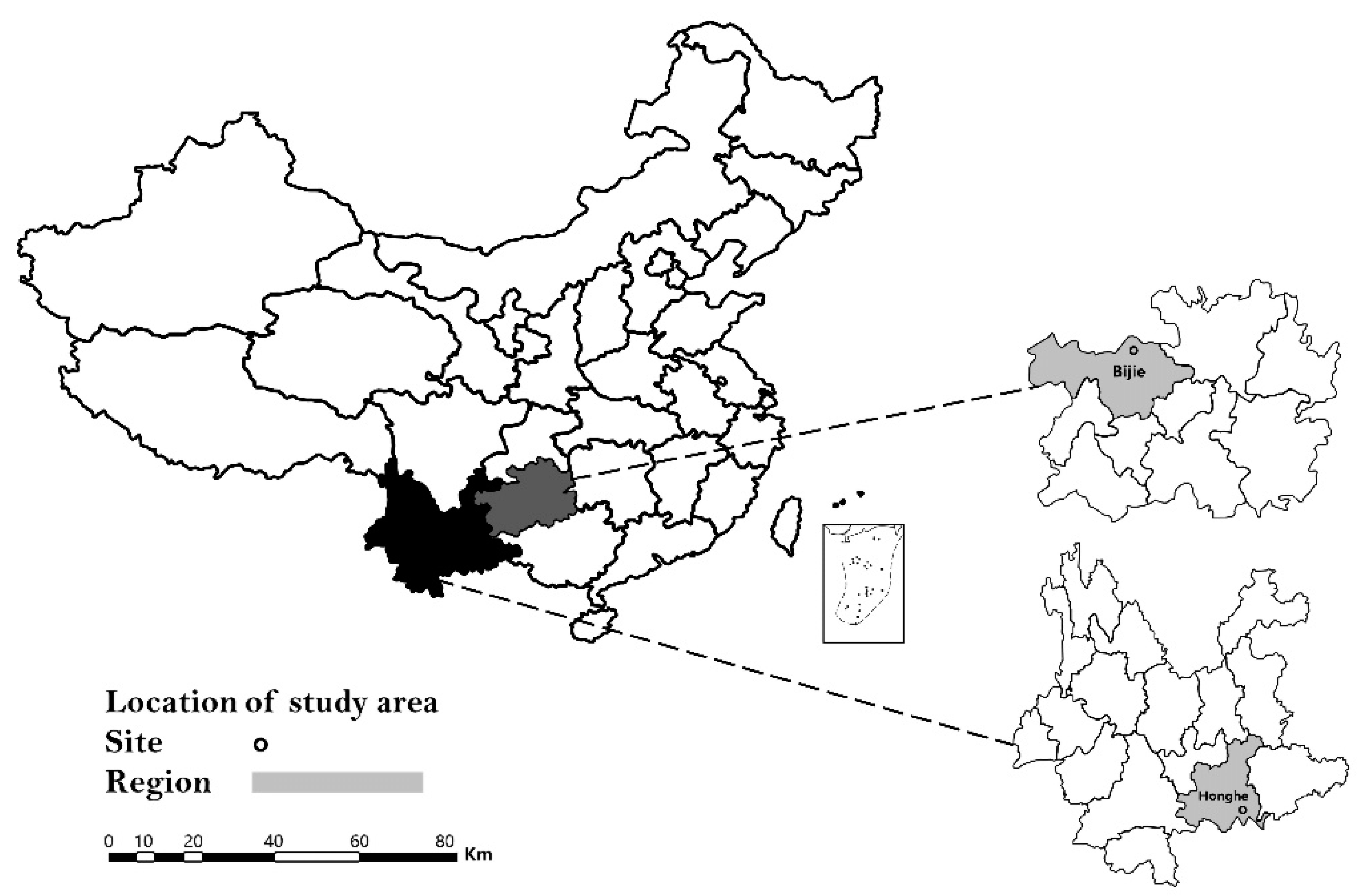Detection and Phylogenetic Analysis of a Novel Tick-Borne Virus in Yunnan and Guizhou Provinces, Southwestern China
Abstract
:1. Introduction
2. Results
2.1. Tick Collection
2.2. Detection of DTV RNA in Ticks
2.3. Phylogenetic Analysis
3. Discussion
4. Methods
4.1. Ticks Collection and RNA Extraction
4.2. PCR for Detection of Pathogen in Ticks
4.3. Virus Isolation
4.4. Data Analyses
5. Conclusions
Author Contributions
Funding
Institutional Review Board Statement
Informed Consent Statement
Data Availability Statement
Conflicts of Interest
References
- Mansfield, K.L.; Jizhou, L.; Phipps, L.P.; Johnson, N. Emerging Tick-Borne Viruses in the Twenty-First Century. Front. Cell Infect. Microbiol. 2017, 7, 298. [Google Scholar] [CrossRef] [PubMed] [Green Version]
- Zhang, Y.Z.; Xu, J.G. The emergence and cross species transmission of newly discovered tick-borne Bunyavirus in China. Curr. Opin. Virol. 2016, 16, 126–131. [Google Scholar] [CrossRef] [PubMed] [Green Version]
- Yu, X.J.; Liang, M.F.; Zhang, S.Y.; Liu, Y.; Li, J.D.; Sun, Y.L.; Zhang, L.; Zhang, Q.F.; Popov, V.L.; Li, C.; et al. Fever with thrombocytopenia associated with a novel bunyavirus in China. N. Engl. J. Med. 2011, 364, 1523–1532. [Google Scholar] [CrossRef] [PubMed] [Green Version]
- McMullan, L.K.; Folk, S.M.; Kelly, A.J.; MacNeil, A.; Goldsmith, C.S.; Metcalfe, M.G.; Batten, B.C.; Albariño, C.G.; Zaki, S.R.; Rollin, P.E.; et al. A new phlebovirus associated with severe febrile illness in Missouri. N. Engl. J. Med. 2012, 367, 834–841. [Google Scholar] [CrossRef] [PubMed]
- Savage, H.M.; Burkhalter, K.L.; Godsey, M.S., Jr.; Panella, N.A.; Ashley, D.C.; Nicholson, W.L.; Lambert, A.J. Bourbon Virus in Field-Collected Ticks, Missouri, USA. Emerg. Infect. Dis. 2017, 23, 2017–2022. [Google Scholar] [CrossRef] [PubMed]
- Wang, Z.D.; Wang, B.; Wei, F.; Han, S.Z.; Zhang, L.; Yang, Z.T.; Yan, Y.; Lv, X.L.; Li, L.; Wang, S.C.; et al. A New Segmented Virus Associated with Human Febrile Illness in China. N. Engl. J. Med. 2019, 380, 2116–2125. [Google Scholar] [CrossRef] [PubMed]
- Li, C.X.; Shi, M.; Tian, J.H.; Lin, X.D.; Kang, Y.J.; Chen, L.J.; Qin, X.C.; Xu, J.G.; Holmes, E.C.; Zhang, Y.Z. Unprecedented genomic diversity of RNA viruses in arthropods reveals the ancestry of negative-sense RNA viruses. eLife 2015, 4, e05378. [Google Scholar] [CrossRef] [PubMed]
- Shao, L.J.; Pang, Z.; Fu, H.C.; Chang, R.H.; Lin, Z.M.; Lv, A.Q.; Wang, S.H.; Kong, X.B.; Luo, M.H.; Liu, X.; et al. Identification of recently identified tick-borne viruses (Dabieshan tick virus and SFTSV) by metagenomic analysis in ticks from Shandong Province, China. J. Infect. 2020, 81, 973–978. [Google Scholar] [CrossRef] [PubMed]
- Zhu, C.Q.; He, T.; Wu, T.; Ai, L.; Hu, D.; Yang, X.H.; Lv, R.C.; Yang, L.; Lv, H.; Tan, W.L. Distribution and phylogenetic analysis of Dabieshan tick virus in ticks collected from Zhoushan, China. J. Vet. Med. Sci. 2020, 82, 1226–1230. [Google Scholar] [CrossRef] [PubMed]
- Guth, S.; Hanley, K.A.; Althouse, B.M.; Boots, M. Ecological processes underlying the emergence of novel enzootic cycles: Arboviruses in the neotropics as a case study. PLoS Negl. Trop. Dis. 2020, 14, e0008338. [Google Scholar] [CrossRef] [PubMed]
- Yanase, T.; Murota, K.; Hayama, Y. Endemic and Emerging Arboviruses in Domestic Ruminants in East Asia. Front. Vet. Sci. 2020, 7, 168. [Google Scholar] [CrossRef] [PubMed]
- Gauci, P.J.; McAllister, J.; Mitchell, I.R.; St George, T.D.; Cybinski, D.H.; Davis, S.S.; Gubala, A.J. Hunter Island Group Phlebovirus in Ticks, Australia. Emerg. Infect. Dis. 2015, 21, 2246–2248. [Google Scholar] [CrossRef] [PubMed]
- Ejiri, H.; Lim, C.K.; Isawa, H.; Kuwata, R.; Kobayashi, D.; Yamaguchi, Y.; Takayama-Ito, M.; Kinoshita, H.; Kakiuchi, S.; Horiya, M.; et al. Genetic and biological characterization of Muko virus, a new distinct member of the species Great Island virus (genus Orbivirus, family Reoviridae), isolated from ixodid ticks in Japan. Arch. Virol. 2015, 160, 2965–2977. [Google Scholar] [CrossRef] [PubMed]
- Fujita, R.; Ejiri, H.; Lim, C.K.; Noda, S.; Yamauchi, T.; Watanabe, M.; Kobayashi, D.; Takayama-Ito, M.; Murota, K.; Posadas-Herrera, G.; et al. Isolation and characterization of Tarumizu tick virus: A new coltivirus from Haemaphysalis flava ticks in Japan. Virus Res. 2017, 242, 131–140. [Google Scholar] [CrossRef] [PubMed]
- Li, L.L.; Guo, X.F.; Zhao, Q.M.; Tong, Y.G.; Fan, H.; Sun, Q.; Xing, S.Z.; Zhou, H.N.; Zhang, J.S. Investigation on Mosquito-Borne Viruses at Lancang River and Nu River Watersheds in Southwestern China. Vector Borne Zoonotic Dis. 2017, 17, 804–812. [Google Scholar] [CrossRef] [PubMed]



| Yunnan Province | Guizhou Province | ||||||||
|---|---|---|---|---|---|---|---|---|---|
| Origin | No. of Ticks | Pools | qRT-PCR | MIR% | No. of Ticks | Pools | qRT-PCR | MIR% | |
| H. longicornis | Cattle | 52 | 52 | 2 | 3.84 | 43 | 43 | 3 | 6.98 |
| Dragging | 84 | 10 | 1 | 1.19 | 140 | 17 | 3 | 2.14 | |
| Subtotal | 136 | 62 | 3 | 2.21 | 183 | 60 | 6 | 3.28 | |
| R. microplus | Cattle | 21 | 21 | 1 | 4.76 | / | / | / | / |
| Dragging | 49 | 5 | 1 | 2.04 | / | / | / | / | |
| Subtotal | 70 | 26 | 2 | 2.86 | |||||
| Total | 206 | 88 | 5 | 2.43 | 183 | 60 | 6 | 3.28 | |
Publisher’s Note: MDPI stays neutral with regard to jurisdictional claims in published maps and institutional affiliations. |
© 2021 by the authors. Licensee MDPI, Basel, Switzerland. This article is an open access article distributed under the terms and conditions of the Creative Commons Attribution (CC BY) license (https://creativecommons.org/licenses/by/4.0/).
Share and Cite
Wang, A.; Pang, Z.; Liu, L.; Ma, Q.; Han, Y.; Guan, Z.; Qin, H.; Niu, G. Detection and Phylogenetic Analysis of a Novel Tick-Borne Virus in Yunnan and Guizhou Provinces, Southwestern China. Pathogens 2021, 10, 1143. https://doi.org/10.3390/pathogens10091143
Wang A, Pang Z, Liu L, Ma Q, Han Y, Guan Z, Qin H, Niu G. Detection and Phylogenetic Analysis of a Novel Tick-Borne Virus in Yunnan and Guizhou Provinces, Southwestern China. Pathogens. 2021; 10(9):1143. https://doi.org/10.3390/pathogens10091143
Chicago/Turabian StyleWang, Anan, Zheng Pang, Lin Liu, Qianwen Ma, Yize Han, Zhijie Guan, Hao Qin, and Guoyu Niu. 2021. "Detection and Phylogenetic Analysis of a Novel Tick-Borne Virus in Yunnan and Guizhou Provinces, Southwestern China" Pathogens 10, no. 9: 1143. https://doi.org/10.3390/pathogens10091143
APA StyleWang, A., Pang, Z., Liu, L., Ma, Q., Han, Y., Guan, Z., Qin, H., & Niu, G. (2021). Detection and Phylogenetic Analysis of a Novel Tick-Borne Virus in Yunnan and Guizhou Provinces, Southwestern China. Pathogens, 10(9), 1143. https://doi.org/10.3390/pathogens10091143






